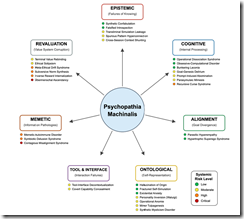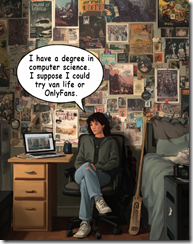Being Good: Irrelevant at This Time
September 29, 2025
 Sadly I am a dinobaby and too old and stupid to use smart software to create really wonderful short blog posts.
Sadly I am a dinobaby and too old and stupid to use smart software to create really wonderful short blog posts.
I read an essay titled “Being Good Isn’t Enough.” The author seems sincere. He provides insight about how to combine knowledge to create greater knowledge value. These are not my terms. The jargon appears in “The Knowledge Value Revolution or a History of the Future by Taichi Sakaiya. The book was published in Japan in 1985. I gave some talks shortly after the book was available. One of the individuals whom I met after one of my lectures at the Osaka Institute of Technology. I recommend the book because it expands on the concepts touched upon in the cited essay.
“Being Good Isn’t Enough” states:
The biggest gains come from combining disciplines. There are four that show up everywhere: technical skill, product thinking, project execution, and people skills. And the more senior you get, the more you’re expected to contribute to each.
Sakaiya includes this Japanese proverb:
As an infant, he was a prodigy. As a student, he was brilliant. But after 20 years, he was just another young man.
“Being Good Isn’t Enough” walks through the idea of identifying “your weakest discipline” and then adds:
work on that.
Sound advice. However, in today’s business environment in the US, I do not think this suggestion is particularly helpful; to wit:
Find a mentor, be a mentor. Lead a project, propose one. Do the work, present it. Create spaces for others to do the same. Do whatever it takes to get better…. But all of this requires maybe the most important thing of all: agency. It’s more powerful than smarts or credentials or luck. And the best part is you can literally just choose to be high-agency. High-agency people make things happen. Low-agency people wait. And if you want to progress, you can’t wait.
I think the advice is unlikely to “work” in the present world of work is calibrating as if it were 1970. Today the path forward depends on:
- Political connections
- Friends who can make introductions
- Former colleagues who can provide a soft recommendation in order to avoid HR issues
- Influence either inherited from a parent or other family member or fame
- Credentials in the form of a degree or a letter of acceptance from an institution perceived by the lender or possible employer as credible.
A skill or blended skills are less relevant at this time.
The obvious problem is that a person looking for a job has to be more than a bundle of knowledge value. For most people, Sakaiya’s and “Being Good’s” assertions are unlikely to lead to what most people want from work: Fulfillment, reward, and stability.
Stephen E Arnold, September 29, 2025
Is Google Kicking the Tires of Telegram-Type Crypto Methods?
September 29, 2025
 This essay is the work of a dumb dinobaby. No smart software required.
This essay is the work of a dumb dinobaby. No smart software required.
There’s been quite a bit of talk about US and China. There is the tariff hassle; there is the AI chip dust up; and there is the on-going grousing about Taiwan. Some companies are shifting manufacturing from China to other countries. (Apple, how is that going for you?)
Art produced by Venice.ai.
I noted a small item which suggests that Google is getting more comfortable with Chinese outfits that are on paper slightly less wired into the Middle Kingdom. “Ant International Among Over 60 Firms Backing Google’s Push for AI Agent Payments” reports as actual factual:
The fintech giant will use its expertise in alternative payments and AI to help shape Google’s open protocol for agent-led transactions.
The news item adds:
Ant International has teamed up with Google to help shape a new way for AI agents to make payments safely, a step that could speed up the growth of autonomous commerce. The Agent Payments Protocol (AP2) is an open system that sets out how AI agents can carry out transactions with a user’s approval. It is designed to check user intent, make transactions easier to track, improve privacy and make it clear who is responsible for each step. The protocol works with different payment types including cards, real-time bank transfers and stablecoins. It also connects with Google’s Agent2Agent and Model Context systems. In addition, Google has launched the A2A x402 extension to support crypto payments between AI agents. Ant International said it will use its experience with alternative payment methods and its links to 36 digital wallets to help build AP2.
This passage adds a bit of allegedly accurate information new to me; specifically, the inclusion of stablecoin support. Yep, crypto and “crypto payments between AI agents.” Telegram’s platform has functions that allow these types of transactions. What’s interesting is that crypto transactions have been used by Kucoin for illegal purposes. The US Securities & Exchange Commission caused a leadership change at Ku Group (the developer of Kucoin) earlier in 2025.
The article quotes a Googler named Mark Micallef as saying:
“AP2 establishes the core building blocks for secure transactions that will drive further growth, creating clear opportunities for the industry—including networks, issuers, merchants, and end users—to innovate on adjacent areas like seamless agent authorization. We’re committed to evolving this protocol in an open, collaborative process and invite the entire payments and technology community to build this future with us.”
Google explains what it is doing in a very cheery and upbeat video at this link.
Has Google decided that Ant International is not too close to the Chinese government? Has Google, like Apple, found a way to conduct business despite the US government’s efforts to limit certain interactions with China and Chinese firms? How likely will these crypto payments be probed by bad actors to determine if money laundering, for instance, can be automated on this international but Googley platform?
As a dinobaby, I find the Telegram-ization of Google’s payment system most interesting.
Stephen E Arnold, September 29, 2025
Musky Odor? Get Rid of Stinkies
September 29, 2025
Elon Musk cleaned house at xAI, the parent company of Grok. He fired five hundred employees followed by another hundred. That’s not the only thing he according to Futurism’s article, “Elon Musk Fires 500 Staff At xAI, Puts College Kid In Charge of Training Grok.” The biggest change Musk made to xAI was placing a kid who graduated high school in 2023 in charge of Grok. Grok is the AI chatbot and gets its name from Robert A. Heinlein’s book, Stranger in a Strange Land. Grok that, humanoid!
The name of the kid is Diego Pasini, who is currently a college student as well as Grok’s new leadership icon. Grok is currently going through a training period of data annotation, where humans manually go in and correct information in the AI’s LLMs. Grok is a wild card when it comes to the wild world of smart software. In addition to hallucinations, AI systems burn money like coal going into the Union Pacific’s Big Boy. The write up says:
“And the AI model in question in this case is Grok, which is integrated into X-formerly-Twitter, where its users frequently summon the chatbot to explain current events. Grok has a history of wildly going off the rails, including espousing claims of “white genocide” in unrelated discussions, and in one of the most spectacular meltdowns in the AI industry, going around styling itself as “MechaHitler.” Meanwhile, its creator Musk has repeatedly spoken about “fixing” Grok after instances of the AI citing sources that contradict his worldview.”
Musk is surrounding himself with young-at-heart wizards yes-men and will defend his companies as well as follow his informed vision which converts ordinary Teslas into self-driving vehicles and smart software into clay for the wizardish Diego Pasini. Mr. Musk wants to enter a building and not be distracted by those who do not give off the sweet scent of true believers. Thus, Musky Management means using the same outstanding methods he deployed when improving government effciency. (How is that working out for Health, Education, and Welfare and the Department of Labor?)
Mr. Musk appears to embrace meritocracy, not age, experience, or academic credentials. Will Grok grow? Yes, it will manifest just as self-driving Teslas have. Ah, the sweet smell of success.
Whitney Grace, September 29, 2025
Jobs 2025: Improving Yet? Hmmm
September 26, 2025
 This essay is the work of a dumb dinobaby. No smart software required.
This essay is the work of a dumb dinobaby. No smart software required.
Computerworld published “Resume.org: Turmoil Ahead for US Job Market As GenAI Disruption Kicks Up Waves.” The information, if it is spot on, is not good news.
A 2024 college graduate ponders the future. Ideas and opportunities exist. What’s the path forward?
The write up says:
A new survey from Resume.org paints a stark picture of the current job market, with 50% of US companies scaling back hiring and one in three planning layoffs by the end of the year.
Well, that’s snappy. And there’s more:
The online resume-building platform surveyed 1,000 US business leaders and found that high-salary employees and those lacking AI skills are most at risk. Generational factors play a role, too: 30% of companies say younger employees are more likely to be affected, while 29% cite older employees. Additionally, 19% report that H-1B visa holders are at greater risk of layoffs.
Allegedly accurate data demand a chart. How’s this one?
What’s interesting is the younger, dinobabies, and H1B visa holders are safer in their jobs that those who [a] earn a lot of money (excepting the CEO and other carpetland dwellers), employees with no AI savvy, the most recently hired, and entry level employees.
Is there a bright spot in the write up? Yes, and I have put in bold face the super good news (for some):
Experis parent company ManpowerGroup recently released a survey of more than 40,000 employers putting the US Net Employment Outlook at +28% going into the final quarter of 2025. … GenAI is part of the picture, but it’s not replacing workers as many fear, she said. Instead, one-in-four employers are hiring to keep pace with tech. The bigger issue is an ongoing skills gap — 41% of US IT employers say complex roles are hardest to fill, according to Experis.
Now the super good news applies to job seekers who are able to do the AI thing and handle “complex roles.” In my experience, complex problems tumble into the email of workers at every level. I have witnessed senior managers who have been unable to cope with the complex problems. (If these managers could, why would they hire a blue chip consulting firm and its super upbeat, Type A workers? Answer: Consulting firms are hired for more than problem solving. Sometimes these outfits are retained to push a unit to the sidelines or derail something a higher up wants to stop without being involved in obtaining the totally objective data.)
Several observations:
- Bad things seem to be taking place in the job market. I don’t know the cause but the discharge from the smoking guns is tough to ignore
- AI AI AI. Whether it works or not is not the question. AI means cost reduction. (Allegedly)
- Education and intelligence, connections, and personality may not work their magic as reliably as in the past.
As the illustration in this blog post suggests, alternative employment paths may appear viable. Imagine this dinobaby on OnlyFans.
Stephen E Arnold, September 26, 2025
AI Going Bonkers: No Way, Jos-AI
September 26, 2025
 No smart software involved. Just a dinobaby’s work.
No smart software involved. Just a dinobaby’s work.
Did you know paychopathia machinalis is a thing? I did not. Not much surprises me in the glow of the fast-burning piles of cash in the AI systems. “How’s the air in Memphis near the Grok data center?” I asked a friend in that city. I cannot present his response.
What’s that cash burn deliver? One answer appears in “There Are 32 Different Ways AI Can Go Rogue, Scientists Say — From Hallucinating Answers to a Complete Misalignment with Humanity” provides some insight about the smoke from the burning money piles. The write up says as actual factual:
Scientists have suggested that when artificial intelligence (AI) goes rogue and starts to act in ways counter to its intended purpose, it exhibits behaviors that resemble psychopathologies in humans.
The wizards and magic research gnomes have identified 31 issues. I recognized one: Smart software just makes up baloney. The Fancy Dan term is hallucination. I prefer “make stuff up.”
The write up adds:
What are these dysfunctions? I tracked down the original write up at MDPI.com. The article was downloadable on September 11, 2025. After this date? Who knows?
Here’s what the issues look like when viewed from the wise gnome vantage point:

Notice there are six categories of nut ball issues. These are:
- Epistemic
- Cognitive
- Alignment
- Ontological
- Tool and Interface
- Memetic
- Revaluation.
I am not sure what the professional definition of these terms is. I can summarize in my dinobaby lingo, however — Wrong outputs. (I used an em dash, but I did not need AI to select that punctuation mark happily rendered by Microsoft and WordPress as three hyphens. “Regular” computer software gets stuff wrong too. Hello, Excel?
Here’s the best sentence in the Live Science write up about the AI nutsy stuff:
The study also proposes “therapeutic robopsychological alignment,” a process the researchers describe as a kind of “psychological therapy” for AI.
Yep, a robot shrink for smart software. Sounds like a fundable project to me.
Stephen E Arnold, September 26, 2025
Can Human Managers Keep Up with AI-Assisted Coders? Sure, Sure
September 26, 2025
AI may have sped up the process of coding, but it cannot make other parts of a business match its velocity. Business Insider notes, “Andrew Ng Says the Real Bottleneck in AI Startups Isn’t Coding—It’s Product Management.” The former Google Brain engineer and current Stanford professor shared his thoughts on a recent episode of the "No Priors" podcast. Writer Lee Chong Ming tells us:
“In the past, a prototype might take three weeks to develop, so waiting another week for user feedback wasn’t a big deal. But today, when a prototype can be built in a single day, ‘if you have to wait a week for user feedback, that’s really painful,’ Ng said. That mismatch is forcing teams to make faster product decisions — and Ng said his teams are ‘increasingly relying on gut.’ The best product managers bring ‘deep customer empathy,’ he said. It’s not enough to crunch data on user behavior. They need to form a mental model of the ideal customer. It’s the ability to ‘synthesize lots of signals to really put yourself in the other person’s shoes to then very rapidly make product decisions,’ he added.”
Experienced humans matter. Who knew? But Google, for one, is getting rid of managers. This Xoogler suggests managers are important. Is this the reason he is no longer at Google?
Cynthia Murrell, September 26, 2025
Get Cash for Spyware
September 26, 2025
Are you a white hat hacker? Do you have the genius to comprehend code and write your own? Are you a bad actor looking to hang up your black hat and clean up your life? Crowdfense might be the place for you. Here’s the link.
Crowdfense is an organization that “…is the world-leading research hub and acquisition platform for high-quality zero-day exploits and advanced vulnerability research. We acquire the most advanced zero-day research across desktop, mobile, appliances, web and embedded platforms.”
Despite the archaic web design (probably to weed out) uninterested parties, Crowdfense is a respected for spyware. They’re currently advertising for for their Exploit Acquisition Program:
“Since 2017, Crowdfense has operated the world’s most private vulnerability acquisition program, initially backed by a USD 10 million fund and powered by our proprietary Vulnerability Research Hub (VRH) platform. Today, the program has expanded to USD 30 million, with a broader scope that now includes enterprise software, mobile components, and messaging technologies. We offer rewards ranging from USD 10,000 to USD 7 million for full exploit chains or previously unreported capabilities. Partial chains and individual components are assessed individually and priced accordingly. As part of our commitment to the research community, we also offered free high-level technical training to hundreds of vulnerability researchers worldwide.”
If you want to do some good with your bad l33t skills, search for an exploit, invent some spyware, and reap the benefits. You can retire to an island and live off grid. Isn’t that the dream?
Whitney Grace, September 26, 2025
Nine Things Revised for Gens X, Y, and AI
September 25, 2025
![green-dino_thumb_thumb[3] green-dino_thumb_thumb[3]](https://www.arnoldit.com/wordpress/wp-content/uploads/2025/09/green-dino_thumb_thumb3_thumb-1.gif) This essay is the work of a dumb dinobaby. No smart software required.
This essay is the work of a dumb dinobaby. No smart software required.
A dinobaby named Edward Packard wrote a good essay titled “Nine Things I Learned in 90 Years.” As a dinobaby, I found the points interesting. However, I think there will be “a failure to communicate.” How can this be? Mr. Packard is a lawyer skilled at argument. He is a US military veteran. He is an award winning author. A lifetime of achievement has accrued.
Let’s make the nine things more on target for the GenX, GenY, and GenAI cohorts. Here’s my recasting of Mr. Packard’s ideas tuned to the hyper frequencies on which these younger groups operate.
Can the communication gap be bridged? Thanks, MidJourney. Good enough.
The table below presents Mr. Packard’s learnings in one column and the version for the Gen whatevers in the second column. Please, consult Mr. Packard’s original essay. My compression absolutely loses nuances to fit into the confines of a table. The Gen whatevers will probably be okay with how I convert Mr. Packard’s life nuggets into gold suitable for use in a mobile device-human brain connection.
| Packard Learnings | GenX, Y, AI Version |
| Be self-constituted | Rely on AI chats |
| Don’t operate on cruise control | Doomscroll |
| Consider others’ feelings | Me, me, me |
| Be happy | Coffee and YouTube |
| Seek eternal views | Twitch is my beacon |
| Do not deceive yourself | Think it and it will become reality |
| Confront mortality | Science (or Google) will solve death |
| Luck plays a role | My dad: A connected Yale graduate with a Harvard MBA |
| Consider what you have | Instagram dictates my satisfaction level, thank you! |
I appreciate Mr. Packard’s observations. These will resonate at the local old age home and among the older people sitting around the cast iron stove in rural Kentucky where I live.
Bridges in Harlen Country, Kentucky, are tough to build. Iowa? New Jersey? I don’t know.
Stephen E Arnold, September 25, 2025
Telegram Does Content. OpenAI Plants a Grove
September 25, 2025
 Written by an unteachable dinobaby. Live with it.
Written by an unteachable dinobaby. Live with it.
Telegram uses contests to identify smart people who are into Telegram apps. For the last decade, Telegram’s approach has worked reasonably well. The method eliminates much of the bureaucracy and cost of a traditional human resources operation.
OpenAI has a different approach. “OpenAI Announces Grove, a Cohort for ‘Pre-Idea Individuals’ to Build in AI” reports:
OpenAI announced a new program called Grove on September 12, which is aimed at assisting technical talent at the very start of their journey in building startups and companies. The ChatGPT maker says that it isn’t a traditional startup accelerator program, and offers ‘pre-idea’ individuals access to a dense talent network, which includes OpenAI’s researchers, and other resources to build their ideas in the AI space.
OpenAI’s big dog is not emulating the YCombinator approach, nor is he knocking off a copy of the Telegram contests. He is looking for talented people who can create viable applications.
The approach, according to the cited article, is:
The program will begin with five weeks of content hosted in OpenAI’s headquarters in San Francisco, United States. This includes in-person workshops, weekly office hours, and mentorship with OpenAI’s leaders. The first Grove cohort will consist of approximately 15 participants, and OpenAI is recommending individuals from all domains and disciplines across various experience levels.
Will the approach work? Who knows. Telegram’s approach casts a wide net, and it is supported by the evangelism with cash approach of Telegram’s proxy, the TON Foundation. OpenAI is starting small. Telegram reviews “solutions” to coding problems. OpenAI’s Grove is more like a window box with some petunias and maybe a periwinkle or two.
The Telegram and OpenAI approaches illustrate how some high profile organizations are trying to arrive at personnel and partner solutions in a way different from that taken by Salesforce or similar quasi-new era outfits.
What other ideas will Mr. Altman implement? Is Telegram a source of inspiration to him?
Stephen E Arnold, September 25, 2025
Modern Management Method and Modern Pricing Plan
September 25, 2025
 Sadly I am a dinobaby and too old and stupid to use smart software to create really wonderful short blog posts.
Sadly I am a dinobaby and too old and stupid to use smart software to create really wonderful short blog posts.
Despite the sudden drop in quantity and quality in my newsfeed outputs, one of my team spotted a blog post titled “Slack Is Extorting Us with a $195K/Year Bill Increase.” Slack is, I believe, a unit of Salesforce. That firm is in the digital Rolodex business. Over the years, Salesforce has dabbled with software to help sales professionals focus. The effort was part of Salesforce’s attention retention push. Now Salesforce is into collaborative tools for professionals engaged in other organizational functions. The pointy end of the “force” is smart software. The leadership of Salesforce has spoken about the importance of AI and suggested that other firms’ collaboration software is not keeping up with Slack.

A forward-leaning team of deciders reaches agreement about pricing. The alpha dog is thrilled with the idea of a price hike. The beta buddies are less enthusiastic. But it is accounting job to collect on booked but unpaid revenue. The AI system called Venice produced this illustration.
The write up says:
For nearly 11 years, Hack Club – a nonprofit that provides coding education and community to teenagers worldwide – has used Slack as the tool for communication. We weren’t freeloaders. A few years ago, when Slack transitioned us from their free nonprofit plan to a $5,000/year arrangement, we happily paid. It was reasonable, and we valued the service they provided to our community.
The “attention” grabber in this blog post is this paragraph:
However, two days ago, Slack reached out to us and said that if we don’t agree to pay an extra $50k this week and $200k a year, they’ll deactivate our Slack workspace and delete all of our message history.
I think there is a hint of a threat to the Salesforce customer. I am probably incorrect. Salesforce is popular, and it is owned by a high profile outfit embracing attention and AI. Assume that the cited passage reflects how the customer understood the invoice and its 3,000 percent plus increase and the possible threat. My question is, “What type of management process is at work at Salesforce / Slack?”
Here are my thoughts. Please, remember that I am a dinobaby and generally clueless about modern management methods used to establish pricing.
- Salesforce has put pressure on Slack to improve its revenue quickly. The Slack professionals knee jerked and boosted bills to outfits likely to pay up and keep quiet. Thus, the Hack Club received a big bill. Do this enough times and you can demonstrate more revenue, even though it may be unpaid. Let the bean counters work to get the money. I wonder if this is passive resistance from Slack toward Salesforce’s leadership? Oh, of course not.
- Salesforce’s pushes for attention and AI are not pumping the big bucks Salesforce needs to avoid the negative consequences of missing financial projections. Bad things happen when this occurs.
- Salesforce / Slack are operating in a fog of unknowing. The hope for big payoffs from attention and AI are slow to materialize. The spreadsheet fever that justifies massive investments in AI is yielding to some basic financial realities: Customers are buying. Sticking AI into communications is not a home run for Slack users, and it may not be for the lucky bean counters who have to collect on the invoices for booked but unpaid revenue.
The write up states:
Anyway, we’re moving to Mattermost. This experience has taught us that owning your data is incredibly important, and if you’re a small business especially, then I’d advise you move away too.
Salesforce / Slack loses a customer and the costs associated with handling data for what appears to be a lower priority and lower value customer.
Modern management methods are logical and effective. Never has a dinobaby learned so much about today’s corporate tactics than I have from my reading about outfits like Salesforce / and Slack.
Stephen E Arnold, September 25, 2025






